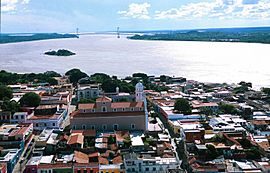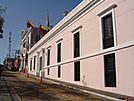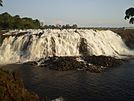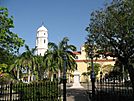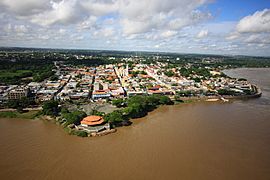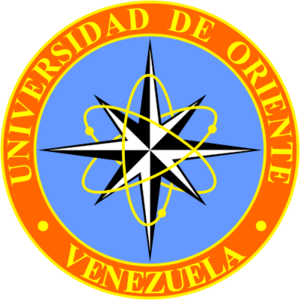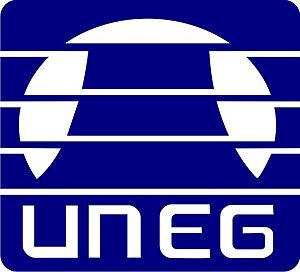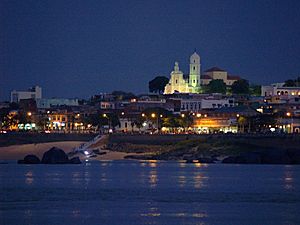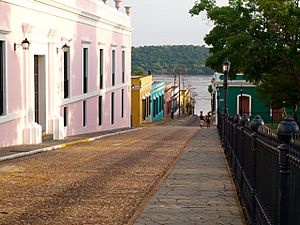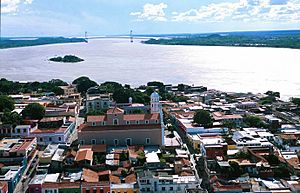Ciudad Bolívar facts for kids
Quick facts for kids
Ciudad Bolívar
Angostura
|
|||
|---|---|---|---|
|
City
|
|||
| Ciudad Bolívar | |||
|
Top:Panoramic view of Ciudad Bolivar, Orinoco River and Angostura Bridge, from Paseo Meneses area, Second:Angostura Regional Congress, Llovizna Falls, (left to right) Third:Bolivar Square and Ciudad Bolivar St. Thomas Cathedral, (both photos) Bottom:An overview of downtown Casco Historico and Orinoco River area
|
|||
|
|||
| Nickname(s):
La puerta del sur de Venezuela
(English:"The gate to southern Venezuela") |
|||
| Motto(s):
No encontrarás otra de más variada riqueza
(English:"You won't find another with such a variety of wealth") |
|||
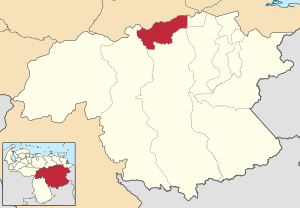
Municipal borders in the state of Bolívar
|
|||
| Country | |||
| State | Bolívar | ||
| Municipality | Heres | ||
| Founded | 22 May 1764 | ||
| Area | |||
| • Total | 209.52 km2 (80.90 sq mi) | ||
| Elevation | 54 m (177 ft) | ||
| Population
(2022)
|
|||
| • Total | 412,619 | ||
| • Density | 1,633.63/km2 (4,231.1/sq mi) | ||
| • Demonym | Bolivarense | ||
| Time zone | UTC−4 (VET) | ||
| Postal code |
8001
|
||
| Area code(s) | 0285 | ||
| Climate | Aw | ||
| Website | Official Site.: https://web.archive.org/web/20140517010950/http://alcaldiaheres.com/ | ||
| The area and population figures are for the city. | |||
Ciudad Bolívar (which means "Bolivar City" in Spanish) is the capital of Venezuela's southeastern Bolívar State. It was once known as Angostura and St. Thomas de Guyana. The city is located where the Orinoco River becomes narrow, about 1 mile (1.6 km) wide. It is also the site of the first bridge built across this big river. Ciudad Bolívar is a very important river port for the eastern parts of Venezuela.
The historic area of Angostura gave its name to important events like the Congress of Angostura. It also inspired the names of the Angostura tree and Angostura bitters, a famous drink ingredient. Today, Ciudad Bolívar has a well-preserved old town. You can find a beautiful cathedral and other original colonial buildings around the main square, Plaza Bolívar.
Contents
History of Ciudad Bolívar
Ciudad Bolívar started as a Spanish settlement called Santo Tomé de Guayana. This town was a strong port. However, it had to be moved three times. This was because it was often attacked by Carib natives and European rivals like the Dutch and English.
In 1576, the first Saint Thomas of Guyana was near the Caroní River. Dutch forces destroyed it in 1579. The second town was founded in 1595 by Don Antonio de Berrío. He came from New Granada to settle Guiana. This town was moved about 66 km (41 mi) west. In 1617, one of Walter Raleigh's trips attacked this second settlement. His son, Watt Raleigh, died during this attack.
The town was rebuilt in 1620 by Fernando de Berrio. It was placed in a better spot for defense and growing tobacco. However, in 1629, English and Dutch pirates attacked and destroyed it again. They were led by Adrian Jansz Pater. Later, in 1637, the Dutch attacked and burned Saint Thomas of Guyana once more.
The city we know today was officially founded in 1764. Don Joaquin Moreno de Mendoza named it San Tomas de la Nueva Guayana. It was also called Santo Tomé de Guayana de Angostura del Orinoco. The name "Angostura" comes from its location at the narrowest part of the Orinoco River.
Angostura became the capital of Guayana Province. From 1819 to 1821, it hosted the Congress of Angostura. This important meeting led to the creation of Gran Colombia. The famous Angostura bitters were invented here in 1824. However, the company that makes them later moved away.
The city was renamed in 1846 to honor Simon Bolivar. He was a great leader in South American independence.
The famous Venezuelan artist Jesús Rafael Soto was born in Ciudad Bolívar. The Jesús Soto Museum of Modern Art is named after him. It opened in 1973 and was designed by Carlos Raúl Villanueva.
Geography and Climate
Plants and Animals
Along the riverbanks, you can find Moriche palms and scrub oaks. Other common trees include the carob tree and the sarrapia (tonka bean).
The local animals include capybaras, turtles, herons, and parrots. You might also see limpets and iguanas. The rivers are home to fish like Salminus hilarii and Pygocentrus palometa.
Weather in Ciudad Bolívar
Ciudad Bolívar has a tropical savanna climate. This means it has clear wet and dry seasons. The average temperature is about 28.5°C (83.3°F) all year. It stays quite steady, from 27.6°C (81.7°F) in January to 28.9°C (84.0°F) in October.
The dry season is from December to April. During these months, there is little rain. Temperatures are a bit cooler but still hot. They often reach 32°C (90°F) during the day. At night, they drop to around 22°C (72°F).
The wet season runs from May to early November. There is more rain during this time. However, days without rain are still common. Temperatures are usually a little warmer than in the dry season.
On average, Ciudad Bolívar gets about 977 mm (38.5 inches) of rain each year. It rains on about 89 days. The city is quite sunny, with nearly 2900 hours of sunshine per year. That's about 7.9 hours of sunshine every day!
| Month | Jan | Feb | Mar | Apr | May | Jun | Jul | Aug | Sep | Oct | Nov | Dec | Year |
|---|---|---|---|---|---|---|---|---|---|---|---|---|---|
| Record high °C (°F) | 39.9 (103.8) |
39.8 (103.6) |
39.5 (103.1) |
39.7 (103.5) |
40.4 (104.7) |
37.4 (99.3) |
38.2 (100.8) |
37.6 (99.7) |
39.7 (103.5) |
37.9 (100.2) |
38.2 (100.8) |
37.6 (99.7) |
40.4 (104.7) |
| Mean daily maximum °C (°F) | 32.8 (91.0) |
33.9 (93.0) |
35.0 (95.0) |
35.4 (95.7) |
34.6 (94.3) |
32.9 (91.2) |
32.2 (90.0) |
32.5 (90.5) |
33.4 (92.1) |
33.5 (92.3) |
33.0 (91.4) |
32.4 (90.3) |
33.5 (92.3) |
| Daily mean °C (°F) | 26.4 (79.5) |
27.3 (81.1) |
28.4 (83.1) |
29.6 (85.3) |
29.0 (84.2) |
27.4 (81.3) |
26.8 (80.2) |
27.0 (80.6) |
27.4 (81.3) |
27.8 (82.0) |
27.3 (81.1) |
26.5 (79.7) |
27.6 (81.7) |
| Mean daily minimum °C (°F) | 22.7 (72.9) |
23.0 (73.4) |
23.7 (74.7) |
24.7 (76.5) |
24.9 (76.8) |
24.4 (75.9) |
24.0 (75.2) |
24.1 (75.4) |
24.5 (76.1) |
24.5 (76.1) |
24.2 (75.6) |
23.3 (73.9) |
24.0 (75.2) |
| Record low °C (°F) | 17.5 (63.5) |
18.1 (64.6) |
20.0 (68.0) |
12.8 (55.0) |
17.7 (63.9) |
18.2 (64.8) |
18.2 (64.8) |
17.8 (64.0) |
18.0 (64.4) |
18.5 (65.3) |
19.2 (66.6) |
18.0 (64.4) |
12.8 (55.0) |
| Average rainfall mm (inches) | 40.1 (1.58) |
16.5 (0.65) |
22.8 (0.90) |
30.7 (1.21) |
116.0 (4.57) |
284.2 (11.19) |
255.0 (10.04) |
251.5 (9.90) |
120.7 (4.75) |
131.0 (5.16) |
125.1 (4.93) |
80.3 (3.16) |
1,473.9 (58.03) |
| Average rainy days (≥ 1.0 mm) | 4.8 | 2.6 | 2.2 | 2.9 | 8.8 | 14.3 | 15.0 | 13.7 | 8.5 | 8.9 | 8.5 | 7.0 | 97.2 |
| Average relative humidity (%) | 69.5 | 67.5 | 66.0 | 66.5 | 69.5 | 73.5 | 73.5 | 72.5 | 70.5 | 71.0 | 71.5 | 72.0 | 70.2 |
| Mean monthly sunshine hours | 248.0 | 235.2 | 263.5 | 234.0 | 226.3 | 201.0 | 232.5 | 248.0 | 252.0 | 260.4 | 249.0 | 244.9 | 2,894.8 |
| Mean daily sunshine hours | 8.0 | 8.4 | 8.5 | 7.8 | 7.3 | 6.7 | 7.5 | 8.0 | 8.4 | 8.4 | 8.3 | 7.9 | 7.9 |
| Source 1: NOAA (sun 1971–1990) | |||||||||||||
| Source 2: Instituto Nacional de Meteorología e Hidrología (humidity 1970–1998) | |||||||||||||
Economy and Media
The economy of Bolívar state mainly relies on farming and raising animals. People farm crops like maize, cassava, mango, yam, and watermelon. Raising cattle and pigs is also very important. Tourism has become more and more important for the area.
Local TV stations include Bolívar Visión and TV Río. Newspapers in the city are El Bolivarense, El Expreso, El Progreso, and El Luchador.
Education in Ciudad Bolívar
Universidad de Oriente
The Universidad de Oriente (UDO) Núcleo de Bolívar is the main public university in Ciudad Bolívar. It also has campuses in other cities in eastern Venezuela. The Bolívar campus was started on February 20, 1960. Since then, it has become a very important university in southeastern Venezuela.
Today, this UDO campus has different schools. These include a Basic Courses School, a Health Sciences School, and an Earth Sciences School. Students can study subjects like Industrial Engineering, Geological Engineering, Medicine, Nursing, and Bioanalysis.
Universidad Nacional Experimental de Guayana
The Universidad Nacional Experimental de Guayana (UNEG) is another public university in Ciudad Bolívar. It was founded on March 9, 1982. This university was created to be a top regional education center.
The UNEG in Ciudad Bolívar offers degrees in Administration and Accounting, Education, and Tourism.
Other Universities
Ciudad Bolívar also has several other universities and institutes:
- Universidad Simón Rodríguez
- Universidad Gran Mariscal de Ayacucho
- Tecnológico del Estado Bolívar
- Universidad Nacional Abierta
- Instituto Universitario Tecnológico Rodolfo Loero Arismendi
- Universidad Bolivariana de Venezuela
- Instituto Universitario de Tecnológia Antonio José de Sucre
- Universidad Nacional Experimental Politécnica de la Fuerza Armada Nacional
- Universidad Pedagógica Experimental Libertador
- Universidad Central de Venezuela (UCV) – Regional Center Ciudad Bolívar
Culture and Attractions
The historic part of Ciudad Bolívar is a popular place for tourists. It has many old houses and buildings from the colonial period. The Jesús Soto Museum of Modern Art is named after Jesús Rafael Soto, a famous sculptor and painter from the city. The museum shows modern art from Venezuelan and international artists.
Ciudad Bolívar is also the birthplace of many talented musicians. These include Antonio Lauro, Cheo Hurtado, and Iván Pérez Rossi. It is also home to the music group Serenata Guayanesa.
Traditional local foods include desserts made from cashew nuts. These can be eaten plain or roasted with salt. The cassava bread made here is very well known. There are also several dishes made from tortoise meat. One famous dish is Carapacho de Morrocoy Guayanés, which is baked tortoise in its shell. Locals also use cassava juice to make a spicy sauce called Catara.
Transportation
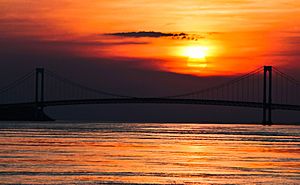
Buses are the main way people travel around the city.
The José Tomás de Heres Airport is located right in the middle of the city.
The Angostura Bridge connects Ciudad Bolívar to the rest of Venezuela. A major highway links Ciudad Bolívar with Ciudad Guayana.
Notable People from Ciudad Bolívar
Many interesting people come from Ciudad Bolívar:
- Darwinzon Hernandez (born 1996), a baseball pitcher for the Boston Redsox.
- Luz Machado (1916–1999), a poet who won the National Prize for Literature in 1987.
- Antonio Lauro (1917–1986), a guitarist and composer. He is considered one of the best South American guitar composers of the 20th century.
- Pompeyo Márquez (1922-2017), a politician. He helped start the Movimiento al Socialismo party.
- Jesús Soto (1923–2005), a famous op and kinetic artist. He was a sculptor and painter.
- Luis García Morales (1929–2015), a poet.
- Milka Chulina (born 1974), who was Miss Venezuela 1993 and placed 2nd runner-up in Miss Universe 1993.
- Victor Martinez (born 1978), a baseball player for the Detroit Tigers.
- Iván Pérez Rossi (born 1943), a singer and composer. He founded the folk music group Serenata Guayanesa.
- Gustavo Rodríguez (1947–2014), an actor in movies, theater, and television.
- Cheo Hurtado (born 1960), a talented player of the cuatro (a Venezuelan instrument).
- Rubén Limardo (born 1985), a fencer. He won an Olympic gold medal in London 2012.
- Carlos Mendoza, a baseball outfielder and coach.
- Rafael Antonio Curra (1934-1968), a marine biologist and director of the Oceanographic Institute of Venezuela.
Images for kids
See also
 In Spanish: Ciudad Bolívar para niños
In Spanish: Ciudad Bolívar para niños


